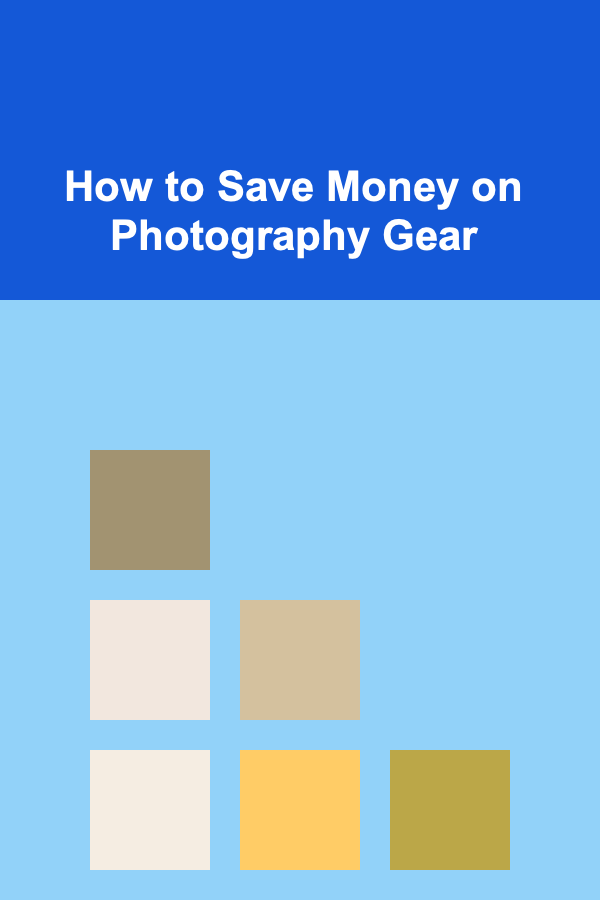
How to Save Money on Photography Gear
ebook include PDF & Audio bundle (Micro Guide)
$12.99$11.99
Limited Time Offer! Order within the next:

Photography is a passion, a profession, and for many, an essential part of capturing the world around us. However, photography gear, especially high-quality cameras, lenses, and accessories, can come with a hefty price tag. For photographers on a budget or those just starting out, it's essential to find ways to save money on photography gear without compromising on the quality of their work. In this article, we'll explore various strategies and tips on how to save money on photography gear, ranging from making smart purchasing decisions to exploring alternatives and utilizing second-hand equipment.
Understand Your Needs vs. Wants
Before purchasing any photography gear, it's crucial to understand your specific needs versus what you simply "want." Many photographers fall into the trap of buying gear they don't actually need, thinking that newer or more expensive equipment will automatically improve their photos. However, this isn't always the case.
Prioritize Based on Your Photography Style
Take a moment to reflect on your photography style. Do you primarily shoot portraits, landscapes, or wildlife? Different genres of photography require different types of gear. For example, portrait photographers might prioritize a high-quality prime lens, while a landscape photographer might focus on a wide-angle lens with a good aperture range.
Assessing your needs will allow you to make more focused purchases. Instead of buying all the latest gear, focus on the few key pieces that will help you excel in your chosen style of photography.
Avoid Gear Obsession
In the age of social media, it's easy to fall into the trap of gear obsession. Photographers often find themselves wanting the latest camera or lens that everyone is raving about. However, it's important to remember that great photography is more about skill and vision than the equipment you use. Resist the urge to buy gear for the sake of having the best and focus instead on improving your techniques.
Buy Used or Refurbished Gear
One of the best ways to save money on photography gear is to buy used or refurbished equipment. Photography gear is often built to last, and many photographers take excellent care of their equipment, so used gear can still be in fantastic condition.
Where to Buy Used Gear
There are numerous online platforms and marketplaces where you can find used photography gear. Some well-known and trusted websites include:
- B&H Photo Video Used Section: B&H is one of the most reputable online retailers for photography gear, and they offer a wide selection of used items.
- KEH Camera: KEH is another respected online marketplace that specializes in buying and selling used camera gear. They also offer a grading system to help buyers understand the condition of the equipment.
- Adorama Used Gear: Similar to B&H, Adorama offers a used gear section with plenty of choices.
- eBay: eBay is a popular place to find used gear, but make sure to carefully read the seller's reviews and check the return policy before making a purchase.
Refurbished Gear
Refurbished gear is another great option. Refurbished items are typically returned items that have been tested, repaired, and restored to like-new condition. Many manufacturers offer refurbished models at a discount, and they often come with warranties. Some reliable manufacturers that offer refurbished cameras and lenses include Canon, Nikon, and Sony.
Take Advantage of Sales and Discounts
There are several opportunities throughout the year when you can find discounts on photography gear. Sales events, promotional offers, and even clearance sections are ideal times to buy new equipment at a reduced price.
Key Sales Events
- Black Friday and Cyber Monday: These sales events are known for massive discounts on electronics, including cameras and lenses. If you've been eyeing a particular piece of gear, this is the perfect time to make your purchase.
- Holiday Sales: Many retailers offer sales around the holiday season, particularly near Christmas and New Year's, where you can find good deals on photography gear.
- Manufacturer Promotions: Occasionally, camera manufacturers such as Canon, Nikon, or Sony run special promotions, offering discounts on selected models or bundles.
- Amazon Prime Day: Amazon's annual sale often includes discounts on photography gear, making it a good time to score deals.
- Local Camera Stores: Don't overlook your local camera shop! Many stores have seasonal sales or clearances, and by shopping locally, you can often negotiate better prices or find exclusive discounts.
Be Aware of Bundles
Sometimes, buying gear in bundles can save you money in the long run. Many camera retailers offer discounted bundles that include a camera body, lens, memory cards, batteries, and other accessories. While these bundles might seem like a good deal, make sure you truly need the extra accessories included in the package. If not, it may be cheaper to buy the gear separately.
Rent Gear for Short-Term Use
If you need a particular piece of gear for a short-term project but don't want to invest a large sum of money into it, consider renting. Rental services offer high-quality gear for a fraction of the purchase price.
Rental Services
- Lensrentals: One of the most popular rental services in the U.S., offering a wide range of cameras, lenses, and accessories for photographers and videographers.
- BorrowLenses: Another well-known option that provides affordable rental rates for a variety of photographic equipment.
Renting for Specialized Gear
If you're working on a specific project, such as a wedding or a studio shoot, and need specialized gear like lighting equipment, drones, or a telephoto lens, renting can be a smart option. This allows you to get access to high-end gear without having to make a full purchase.
Avoid Unnecessary Accessories
Photography accessories can add up quickly, but not all accessories are essential. Many photographers find themselves buying gear they never use or don't need. Before purchasing any accessory, ask yourself if it will genuinely enhance your workflow or improve your photography.
Essential Accessories
There are a few accessories that are generally necessary for most photographers, including:
- Memory cards: Always have extra memory cards for your shoots, but avoid buying the most expensive options unless you have specific needs.
- Tripods: A good tripod is essential for stability, particularly in low-light conditions, landscapes, and long-exposure shots.
- Batteries: Extra batteries are always handy, especially for long shoots or when traveling to remote locations.
Avoid Trendy Accessories
While trendy accessories can be fun, they often don't add much value to your photography. Things like camera straps with bold designs, camera bags with excessive compartments, or items marketed as "essential" but rarely used can quickly add unnecessary expenses to your gear list.
Take Care of Your Gear
One of the most effective ways to save money on photography gear is to take good care of your equipment. Proper maintenance and care can extend the lifespan of your gear, meaning you won't have to replace it as often.
Cleaning and Storage
Make sure to clean your gear regularly, including the lens and sensor. Dust, dirt, and oil can quickly degrade the performance of your camera and lenses. Use appropriate cleaning tools such as microfiber cloths, lens cleaning solutions, and air blowers to keep your gear in top condition.
Additionally, store your gear properly. Keep your camera, lenses, and accessories in a padded bag or case to avoid damage. Be mindful of temperature changes, as extreme cold or heat can affect your gear's performance.
Regular Inspections and Repairs
If you notice any issues with your equipment, have it inspected and repaired promptly rather than waiting for it to worsen. Small repairs are often much cheaper than replacing entire pieces of gear. Many camera manufacturers offer repair services, and local camera shops often provide excellent repair options at competitive prices.
Consider Third-Party Brands
While established camera brands like Canon, Nikon, and Sony offer high-quality products, third-party brands often provide similar gear at a fraction of the cost. Many third-party lens manufacturers, such as Sigma, Tamron, and Samyang, offer lenses that are just as good as those made by the original camera brands, often at much more affordable prices.
When choosing third-party gear, read reviews and do your research to ensure the quality and reliability of the product. Third-party gear can offer excellent value, especially for those on a budget.
Conclusion
Photography gear is essential to creating beautiful and professional images, but it doesn't have to break the bank. By understanding your needs, opting for used or refurbished gear, taking advantage of sales, renting gear, avoiding unnecessary accessories, maintaining your equipment, and considering third-party brands, you can save a significant amount of money while still enjoying high-quality gear.
Remember, while gear is important, the true essence of great photography lies in your skills and vision. With careful planning and smart purchasing decisions, you can achieve outstanding results without spending a fortune on equipment.
Reading More From Our Other Websites
- [Home Rental Property 101] Best Ways to Rent Out Your Home and Build a Successful Rental Business
- [Survival Kit 101] How to Customize a Survival Kit for Extreme Cold‑Weather Expeditions
- [Personal Care Tips 101] How to Choose the Best Shampoo for Color-Treated Hair
- [Home Security 101] How to Choose the Right Home Security Monitoring Service
- [Metal Stamping Tip 101] How to Leverage AI‑Driven Quality Inspection for Detecting Defects in Stamped Metal Parts
- [Personal Care Tips 101] How to Use Concealer for Perfecting Your Eye Makeup Look
- [Home Rental Property 101] How to Increase Your Rental Property's Value
- [Home Security 101] How to Secure Your Home's Entry Points with Deadbolts and Reinforcements
- [Personal Investment 101] How to Choose the Right Index Fund for Your Financial Goals: A Step-by-Step Selection Process
- [Home Family Activity 101] How to Engage Kids with STEM Activities at Home

How to Create a Routine for Digital Detox Days
Read More
How to Optimize Your Tax Planning for Maximum Refunds
Read More
How to Remove Odors from Your Home Without Chemicals
Read More
How to Use Content Marketing for Profit
Read More
How to Use Index Funds for Passive Investing
Read More
How to Knit Socks for Beginners: A Step-by-Step Guide
Read MoreOther Products

How to Create a Routine for Digital Detox Days
Read More
How to Optimize Your Tax Planning for Maximum Refunds
Read More
How to Remove Odors from Your Home Without Chemicals
Read More
How to Use Content Marketing for Profit
Read More
How to Use Index Funds for Passive Investing
Read More